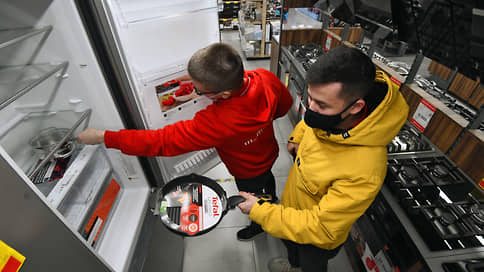Refrigerators are swollen from dollars – Newspaper Kommersant No. 65 (7510) of 04/14/2023
[ad_1]

Selling prices for large household appliances in Russia are growing by an average of 8-10% against the background of the weakening of the ruble, distributors and retailers report. We are talking about both goods imported through parallel imports and official deliveries, for example from China. Market participants specify that in certain categories, for example, among popular models of Samsung and LG TVs, the shortage of goods also affects the rise in price. Experts add that the ability of large companies to create sufficient stocks in warehouses helps to contain price increases.
Selling prices for shops for HVAC equipment from Chinese Hisense have increased by 4-8% since April 12, Kommersant was told in the company. As follows from the letters available to Kommersant, the Gorenje brand, which is part of the Hisense group, notified retailers that from May 1, prices for household appliances will increase by at least 5% due to “a significant increase in prices for raw materials.” Stores received similar letters from the Chinese Midea: the company notified that since March 20, it has increased prices for large and built-in appliances Midea, Toshiba and Comfee “by an average of 5%”. Midea did not answer “Kommersant”.
Alexey Pogudalov, commercial director of Holodilnik.ru, confirmed to Kommersant that they had received letters from Midea and Gorenje. According to him, the last time such notifications came about a year ago, after the outbreak of hostilities in Ukraine.
The reason, according to him, was the weakening of the ruble, so the rise in price will also affect equipment imported to Russia through parallel imports, “all transactions are made in dollars and euros, so the cost of this equipment will increase.”
Mr. Pogudalov said that retail prices will increase in line with the increase in purchase prices from vendors – within 10%.
Gleb Mishin, the head of the representative office of the Candy-Hoover Group household appliance manufacturer in Russia (part of the Chinese Haier Group), also said that their company is forced to raise the price of its products due to the exchange rate, without specifying the figures, “as for the electronics that are produced on the territory of Russia, everything will depend on the level of localization.” If a lot of foreign components are used, then the cost of the final equipment will grow proportionally, if it is minimal or completely localized, then the cost will remain the same, says Mr. Mishin.
Since the beginning of April, the dollar has added more than 4 rubles in price, the euro – more than 6 rubles. Their courses have repeatedly updated records (see “Kommersant” dated April 7). Prices for household appliances over the past two months have already increased by an average of 10% precisely because of exchange rate fluctuations, “now this is the only factor that affects the market, there have been no logistical and regulatory changes,” says F + tech-Marvel Group of Companies . They separately noted the increase in prices for Samsung and LG TVs, caused by “a serious shortage of popular models in sources of parallel imports.”
Retailers with large warehouses are trying to keep the same prices, F + tech-Marvel emphasized.
Meanwhile, Kommersant found an increase in retail prices for electronics, including in large stores, and much more significantly than the level confirmed by retailers and manufacturers.
In particular, from April 7 to April 12, M.Video increased prices for certain models of Samsung TVs (from 64.9 thousand rubles and a discount of 5 thousand rubles to 74.9 thousand rubles) and Realme (from 23.9 thousand to 26.9 thousand rubles), Gorenje refrigerators (from 41.9 thousand to 53.9 thousand rubles).
M.Video-Eldorado, however, assured that it was not about raising prices, but about the end of promotions. “Now we do not see clear prerequisites for a significant change in prices. The situation on the market is quite stable in terms of both the range and availability of goods, and their cost,” they noted.
International electronics manufacturers have always been heavily dependent on currency fluctuations, says Anton Guskov, a representative of the RATEK association of trading companies and commodity producers of household electrical and computer equipment (it includes, for example, M.Video-Eldorado, DNS, Samsung and others). “Based on the experience of early 2022, when some electronics doubled in price, we can say that further price increases or decreases will depend, among other things, on the long-term currency fluctuations. If growth continues, then the cost of equipment will rise,” he says.
[ad_2]
Source link





